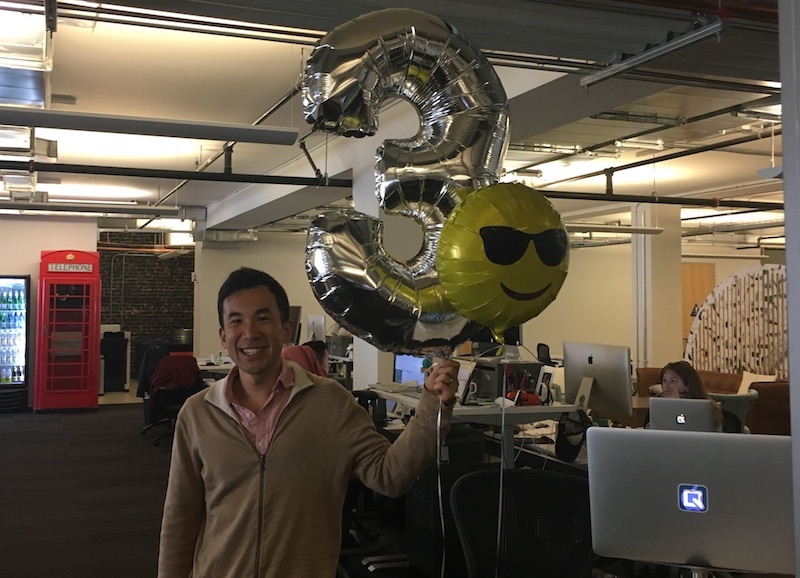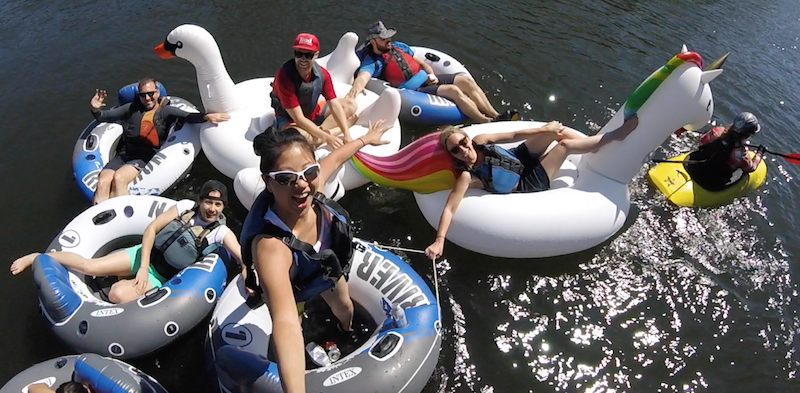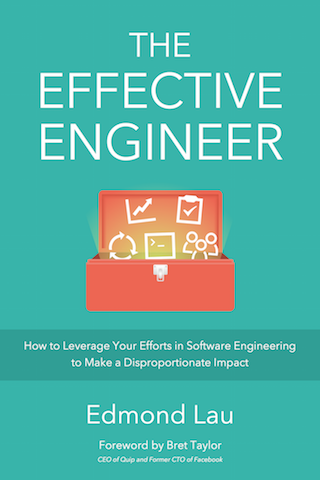Share Powerful Stories to Shift the Culture Around You

A few months ago, I passed my three-year anniversary of working at Quip. It’s the longest I’ve worked at any company, and my experience here has also differed significantly from other startups I’ve worked at.
Many of us are either already in leadership roles, or we’re starting to wonder what our personal path toward leadership might look like. And part of leadership – whether you’re a senior engineer, tech lead, a manager, a director, or someone else – is shaping the culture around you through the stories you choose to tell. The stories you emphasize and pass along become the lore that form core values.
And so, I’m sharing a montage of my favorite stories from working at Quip because my experience here has dramatically shifted my own perspective of what’s possible in Silicon Valley startup culture. I originally posted these stories in response to a Quora question on “What is it like to work at Quip?” My hope is that you can find inspiration from these stories when it comes time to share your own.
Grab a snack and settle in for story time.
Want a job? Here’s your support ticket
I didn’t know anyone at Quip when I first applied for a job here — the company only had 14 people back then. Before reaching out to my network for a referral, I thought I’d just send a email to jobs@quip.com to see what might happen. Within a day, someone responded!
Josh, an intern at the time, assigned me customer support ticket #1837. He introduced me to Kevin Gibbs, the head of engineering, and we scheduled a time to meet. Josh then marked my support ticket as closed as a matter of fact. The rest is history.
I received an amusing, automated request, asking “How would you rate the support you received?” Very well, thank you! Our customer support and recruiting have obviously grown significantly since then.
Invest in people first
A year and a half ago, I hit a wall. I wasn’t feeling motivated about my work.
I was curious to explore something I was excited about — leadership coaching. I had spent a large portion of my career mentoring other engineers — both at and outside of work — and coaching seemed like a natural extension. Why not learn how world-class leadership coaches did it? The bigger question though was whether I could fit my development as a leadership coach into my work at Quip.
I scheduled a one-on-one conversation with Kevin, the co-founder.
My heart raced during our conversation — I didn’t really know what to expect.
I walked through the arguments that I had rehearsed with my wife the night before. I asked to dedicate 20% of my time toward coaching-related activities — whether it was developing my coaching skills or even coaching engineers outside of Quip. The investment would open doors toward creating more value for Quip in the long run.
But it also had a short-term cost. Our startup had such a small team back then — we still do. And it would mean that I’d spend less time working on the product.
What happened next caught me by surprise. Kevin supported the proposal without skipping a beat. The answer was completely obvious to him. “No” wasn’t even in the realm of possibility. He only asked that I channel half of that investment back into the team in some way.
Later, when Diana, a product manager at Quip, expressed an interest in leadership coaching as well, the company supported the two of us in doing over a hundred hours of training with the Coaches Training Institute.
That one-on-one was a powerful inflection point for me at Quip. I entered the conversation feeling anxious, uncertain, and unmotivated, and I left having done a complete 180 — I felt supported, excited, and re-inspired that Quip was a willing ally in my personal and professional growth.
This was my first real inkling of the people-first approach at Quip — a firm belief that good things come from investing in people first and in prioritizing people over projects.
Work hard, but don’t stress out
When I interviewed for a job at the 14-person company, I asked Patrick Linehan — an engineer on the team — how stressful it was to work at Quip. My previous experiences as an early engineer at both Quora and Ooyala created a picture that early-stage startups tended to be intense and stressful. I had ZERO desire to go back to a world of 60-80 hour work weeks.
I was surprised to hear him say, “Not stressful at all.” And I’ve been even more pleasantly surprised to have found it be true.
In my three and a half years at Quip, I can count the number of times I’ve been paged outside of work hours with one hand. Besides the infrequent, urgent customer issues, there’s no expectation that engineers are working outside of work hours or beyond 40-hour weeks.
Build a sustainable working environment
During my first year at the company, at an all-hands meeting, Kevin acknowledged that an engineering project was falling behind schedule. We’re either going to have to cut back some features or push back the deadline, he said. Working late nights or weekends to hit the deadline — the norm at many companies — was explicitly ruled out as an option.
The interaction showed a huge level of maturity and discipline on the team and in leadership. We all want Quip to succeed massively, and that means we need to take a sustainable approach toward work that operated on a long-term time scale.
Work is not the most important thing
Within little more than a year of me joining, 7 out of the 14 people initially there — including both founders, Bret and Kevin — had taken parental leave, all for at least a month and most for several months.
The first reaction that people tend to have is, “Wow, that’s a lot of babies!” And the second reaction tends be one of surprise that our small startup had such a family-friendly culture. I’ve always appreciated the support for everyone to take time off for family matters.
Another time, I posted a message to the company chat room that I was sick and wouldn’t be coming in. And I received a thoughtful note from Kevin wishing that I felt better soon and “please do not worry about work at all.” Life happens, and we all need to take care of ourselves.

2016 Innertubing Extravaganza. Courtesy of Brina Lee.
Supporting 8 different platforms with only 13 engineers
Those familiar with my writing know the lessons I’ve shared from multi-month software rewrite projects gone terribly awry, even with the most well-intentioned teams. At Ooyala, for example, a 4-month rewrite project turned into a 9-month marathon filled with 70-80 hour work weeks.
So it was with much trepidation that I approached our team’s rewrite of the Quip web client from server-side Python templates to client-side rendering with React. The rewrite was part of a new architecture to provide native, offline Quip support on Mac and Windows. We made a number of strategic decisions that hugely reduced risk, including rewriting and deploying our code incrementally so that we could support a hybrid of Python and React code in production.
The migration ranks among the smoothest executions of a project of that complexity I’ve been involved with. As a result, we successfully shipped our product onto 8 different platforms with an initial team of only 13 engineers — a testament to our strong technical leadership (particularly from Jon McAlister and Mihai Parparita) and our incredible team of engineers here.
My years at Quip have taught me a new level of appreciation of what it means to work effectively on a team, beyond what I’ve already written about in my book, The Effective Engineer.
Build better tools, all the time
I felt super excited for my first day at Quip, but some of my excitement was deflated when it took most of my first day to properly set up the development environment on my new laptop. We had an “automated” setup script, but since I was the first engineering hire in a while, large chunks of it were out of date. Fixing that script was my first inadvertent task.
Since then, we’ve moved our development environment to Docker, and it now takes new hires under an hour to get their laptops set up. Quip engineer Shrey Banga has written about some of our tooling investments, and it’s amazing how far that strong, long-term focus has gotten us in the past few years.
Use Quip with your team and get a free t-shirt
One time, I was brainstorming with Nate Botwick, a product manager at Quip, and Patrick Moran in marketing on the ways we could accelerate the adoption of Quip. People love Quip once they take the time to try it out, but the friction to try out a new product can be high.
What if we sent people a free t-shirt for trying out Quip with their teams? Within a few weeks, we had built out a new user flow where we incentivized people to try out the product with their teams in exchange for a free t-shirt. This experiment turned out to be a fun, powerful, and cost-effective way to get people hooked into the product.
And that experience has also been representative of how cross-functional and collaborative the projects at Quip have been. Our product launches consistently call for joint efforts across the company, all orchestrated within Quip the product, of course.
Employee of the month
A while back, a mysterious package appeared in the office. It turned out to be a hand-painted portrait of one of our product managers, Nate Botwick, for our first-ever employee of the month. He deserved it!

Nate Botwick, our first employee of the month.
It turns out there are companies that will hand-paint large portraits based on digital pictures you send them. For a while, we kept this running joke going on and cycled through many members of the team — decorating our hallways with portraits of our team — until it stopped scaling.
We now have a conference room called Employee of the Month, where our portraits still hang on the wall.
Invest in people always
When I think back to my one-on-one conversation with Kevin and subsequent ones that we’ve had, the underlying value there has always been a strong commitment to personal growth.
That people-first mindset forms the foundation for the culture that makes Quip special.
I feel empowered to creatively shape the work I do — so that it aligns what I’m most excited about and where I most want to grow with what will create value for the organization. And I also notice others doing their own creative explorations, sometimes even by changing their roles at the company.
The approach makes sense. When people are learning and growing, they’re more motivated. And when they’re more motivated, they bring the newfound energy back into their work, often finding creative new ways to both further their own learning AND create more value for the company.
It’s also smart. In a world where engineering and product hiring is hard, why wouldn’t you invest in people’s growth? Why wouldn’t you value people over the short-term gains you might be able to squeeze out of a project?
A big challenge that Kevin’s posed to me and others at Quip is how we can take what we’ve learned to help accelerate growth for the rest of the team. And that emphasis on personal growth shows up in all the ways that we formally and informally support people on the team.
I see the commitment to personal growth in our feedback sessions program that Brina Lee started, where we randomly match up 2-3 people from engineering, product, and design every couple weeks to exchange in-person feedback. We have honest 30-60 minute conversations about what we would like to see more of from each other, what assumptions we might have about the other person, and what we think is possible.
I see it in the engineering circles I’ve set up to create a space for engineers to discuss hard but important topics. How do we explicitly design our work relationships? When and how do we ask for help? How do we manage our time, energy, and motivation? These topics affect us every day, but most people don’t have a channel for discussing them.
I see it in the tech lead mentorship program that Jon McAlister set up to ensure our leaders are well-supported both technically and emotionally for the responsibilities they have.
I see it in the coaching and mentoring relationships that Diana Kimball and I have set up to leverage our leadership coach training to grow people on the team. And in the upcoming workshop on effective listening that we’ll be co-leading for the team.
I see it in our strong investments in the mentoring and onboarding programs that we’ve set up and review every few weeks, to make sure that new hires are set up for long-term success.
I see it in the pair programming roulette we have set up, where we randomly pair together engineers that are interested to work together on some task. Work’s more fun with a partner.
I see it in all the working groups that people organically form to close the gaps we see and to create more support programs.
And I see these investments in personal growth paying off. We’ve had zero attrition on the engineering, product, and design teams for over a year and a half, and that’s a testament to the culture that we’ve all created here. When we invest in people first, new possibilities open up for what we’re able to do.

Quip and 2017 Diversity Scholarship Winners. Courtesy of Brina Lee.
That’s it for story time. These stories defined and shaped my experience at Quip so far. And they’ve also raised the bar for what I now know is possible for culture in the tech industry. What stories will you tell to define and shape your own work experience?
Thanks to Diana Berlin and Chen Xiao for reading drafts of this post.

The Effective Engineering Leader Workshop
Break free of your own limiting beliefs, take control of your own story, and develop the authentic leader within you.

“A comprehensive tour of our industry's collective wisdom written with clarity.”
— Jack Heart, Engineering Manager at Asana
“Edmond managed to distill his decade of engineering experience into crystal-clear best practices.”
— Daniel Peng, Senior Staff Engineer at Google

“A comprehensive tour of our industry's collective wisdom written with clarity.”
— Jack Heart, Engineering Manager at Asana
“Edmond managed to distill his decade of engineering experience into crystal-clear best practices.”
— Daniel Peng, Senior Staff Engineer at Google


















Leave a Comment